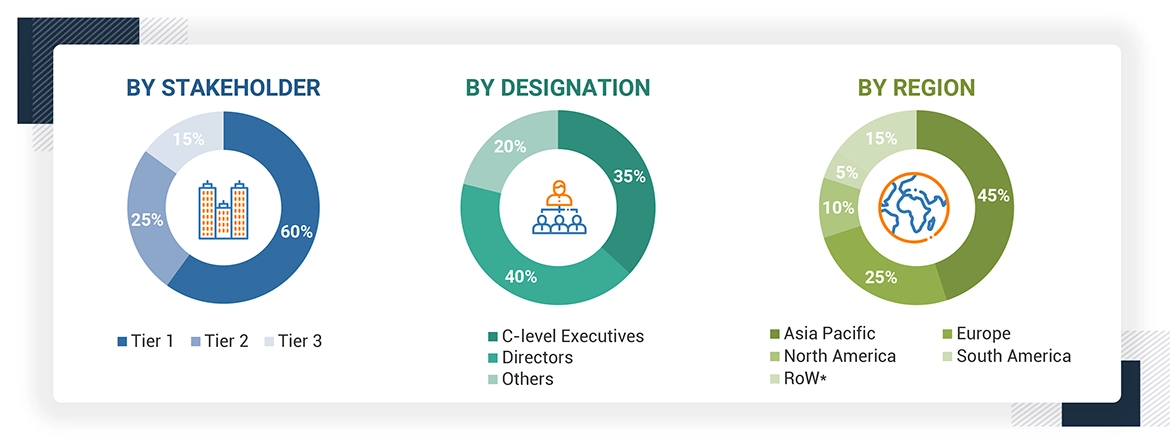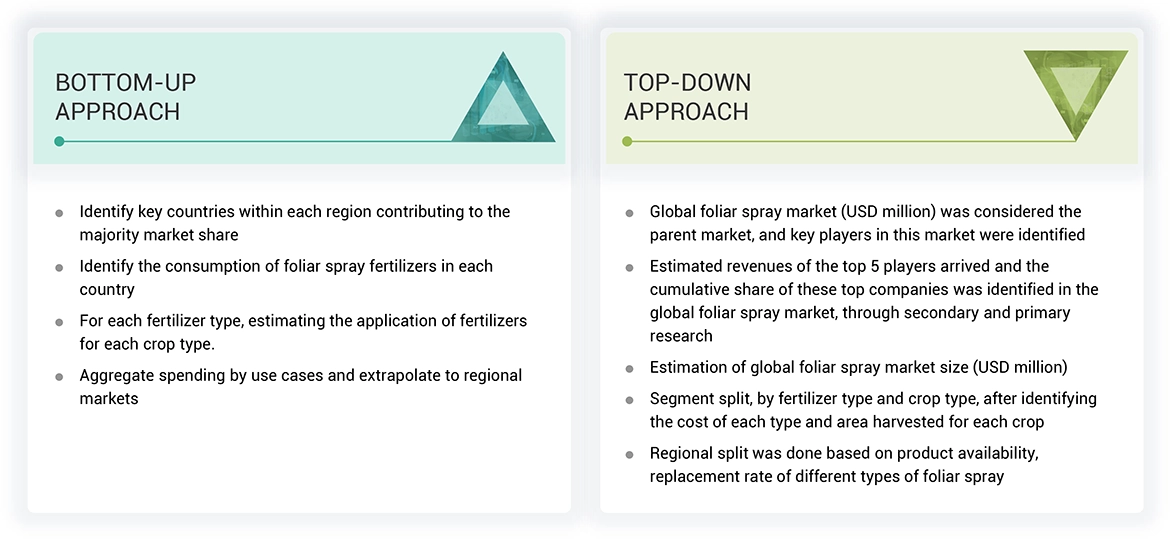The study involved four major activities in estimating the current size of the foliar spray market. Exhaustive secondary research was done to collect information on the market, peer market, and parent market. The next step was to validate these findings, assumptions, and sizing with industry experts across the value chain through primary research. Both top-down and bottom-up approaches were employed to estimate the complete market size. After that, market breakdown and data triangulation were used to estimate the market size of segments and subsegments.
Secondary Research
This research study involved the extensive use of secondary sources—directories and databases such as Bloomberg Businessweek and Factiva—to identify and collect information useful for a technical, market-oriented, and commercial study of the foliar spray market.
Secondary research was mainly used to obtain key information about the industry’s supply chain, the total pool of key players, and market classification and segmentation as per the industry trends to the bottom-most level, regional markets, and key developments from both market- and technology-oriented perspectives.
Primary Research
Extensive primary research was conducted after obtaining information regarding the foliar spray market scenario through secondary research. Several primary interviews were conducted with market experts from both, the demand and supply sides across major countries of North America, Europe, Asia Pacific, the Middle East & Africa, and Latin America. Primary data was collected through questionnaires, emails, and telephonic interview. The primary sources from the supply side included various industry experts, such as Chief X Officers (CXOs), Vice Presidents (VPs), Directors, from business development, marketing, research and development teams, and related key executives from distributors; and key opinion leaders. Primary interviews were conducted to gather insights such as market statistics, data of revenue collected from the products and services, market breakdowns, market size estimations, market forecasting, and data triangulation. Primary research also helped in understanding the various trends related to types of foliar sprays, form, application, and region. Stakeholders from the demand side, such as food and beverage companies and health and personal care companies who are using foliar spray were interviewed to understand the buyer’s perspective on the suppliers, products, and their current usage of foliar spray and future outlook of their business which will affect the overall market

Note: The three tiers of the companies are defined on the basis of their total revenues in 2021 or 2022, as per the availability of financial data; Tier 1: Revenue > USD 1 billion; Tier 2: USD 100 million ≤ Revenue ≤ USD 1 billion; Tier 3: Revenue < USD 100 million.
About the assumptions considered for the study, To know download the pdf brochure
|
COMPANY NAME
|
Designation
|
|
EuroChem Group AG (Switzerland)
|
General Manager
|
|
Nutrien Ltd. (Canada)
|
Sales Manager
|
|
K+S Aktiengesellschaft (Germany)
|
Director
|
|
Yara International (Norway)
|
Individual Industry Expert
|
|
Israel Chemical Ltd. (Israel)
|
Marketing Manager
|
|
The Mosaic Company (US)
|
Sales Executive
|
|
Gujarat State Fertilizers & Chemicals Ltd. (India)
|
Sales Manager
|
|
Coromandel International Limited (India)
|
Individual Industry Expert
|
|
Tribodyn AG (Germany)
|
Manager
|
|
Hebei Monband Water Soluble Fertilizer Co., Ltd. (China)
|
Individual Industry Expert
|
Market Size Estimation
Both the top-down and bottom-up approaches were used to estimate and validate the total size of the foliar spray market. These approaches were also used extensively to determine the size of various subsegments in the market. The research methodology used to estimate the market size includes the following details:
-
The key players in the industry and the overall markets were identified through extensive secondary research.
-
The revenues of the major foliar spray players were determined through primary and secondary research, which were used as the basis for market sizing and estimation.
-
All percentage shares, splits, and breakdowns were determined using secondary sources and verified through primary sources.
-
All macroeconomic and microeconomic factors affecting the growth of the foliar spray market were considered while estimating the market size.
-
All possible parameters that affect the market covered in this research study were accounted for, viewed in extensive detail, verified through primary research, and analyzed to obtain final quantitative and qualitative data.

Data Triangulation
After arriving at the overall size from the market size estimation process explained above, the total market was split into several segments and subsegments. The data triangulation and market breakdown procedures explained below were implemented, wherever applicable, to complete the overall market engineering process and arrive at the exact statistics for various market segments and subsegments. The data was triangulated by studying various factors and trends from the demand and supply sides. Along with this, the market size was validated using both the top-down and bottom-up approaches.
Market Definition
Foliar spray is the term used to describe the application of a chemical or fertilizer to plants in order to supply them with vital nutrients throughout the vegetative and generative stages. Foliar fertilization is found to increase yields, improve disease and insect resistance, increase drought tolerance, and improve crop quality. The species, fertilizer type, concentration, frequency of application all affect the plant growth. Foliar applications are scheduled with respect to vegetative or fruiting growth stages, and the fertilizer formulation is modified and adjusted accordingly.
Key Stakeholders
-
Manufacturers of Foliar Spray
-
Traders, Distributors, and Suppliers of Foliar Spray
-
Agricultural Farms/Farmers/Self-Help Groups
-
Government and Research Organizations
-
Associations and Industrial Bodies
-
Research and Consulting Firms
-
R&D Institutions
-
Environment Support Agencies
-
Investment Banks and Private Equity Firms
Report Objectives
-
Determining and projecting the size of the foliar spray market, with respect to type, form, application, and regions, over five years, ranging from 2023 to 2028
-
Identifying the attractive opportunities in the market by determining the largest and fastest-growing segments across regions
-
Providing detailed information about the key factors influencing the growth of the market (drivers, restraints, opportunities, and industry-specific challenges)
-
Analyzing the micro-markets with respect to individual growth trends, prospects, and their contribution to the total market
-
Impact of macro- and microeconomic factors on the market
-
Impact of recession on the global foliar spray market
-
Shifts in demand patterns across different subsegments and regions
-
Identifying and profiling the key market players in the foliar spray market
-
Understanding the competitive landscape and identifying the major growth strategies adopted by players across the key regions
Available Customizations
With the given market data, MarketsandMarkets offers customizations according to company-specific scientific needs.
The following customization options are available for the report:
Product Analysis
-
Product Matrix, which gives a detailed comparison of the product portfolio of each company
Geographic Analysis
With the given market data, MarketsandMarkets offers customizations according to company-specific scientific needs.
-
Further breakdown of the Rest of Europe into the Netherlands, Poland, Belgium, Sweden, and other EU & non-EU countries
-
Further breakdown of the Rest of Asia Pacific into Indonesia, Malaysia, Thailand, the Philippines, Singapore, and Vietnam.
-
Further breakdown of South America into Chile, Uruguay, and Peru.
Company Information
-
Detailed analyses and profiling of additional market players (up to five)



Growth opportunities and latent adjacency in Foliar Spray Market